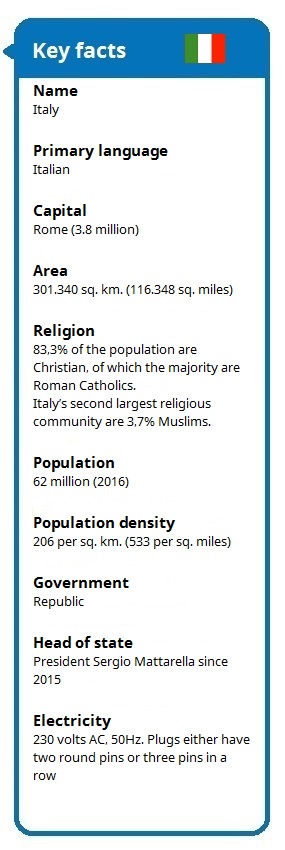 No other country on Earth has more UNESCO World Heritage sites than Italy.
No other country on Earth has more UNESCO World Heritage sites than Italy.
A country filled to the point of bursting with history and culture. A history of consequence as far back as the Roman Empire in the 2nd century BC and even further back to the Etruscans in the 8th century BC and up until this day, Italy has always been a battleground for power. This is truly an interesting country.
Italy must be number one when it comes to culture. The food and wine are fantastic, The fashion is fabulous, the nature is beautiful and the all UNESCO sites are wonderful.
Weather and Climate
Best time to visit Italy is from April to November, but the mild climate ensures, that you can visit Italy all year round.
Italy has a much-diversified climate, which may also be anything else than the well-known hot, dry weather. Inland Italy has a temperate climate with humid weather and a very rich flora. The further south you go, the hotter it gets. You can actually say that everything south of Florence has a subtropical Mediterranean climate with dry and sunny weather. Meanwhile, in the Alps, the weather is at the other end of the climate scale, making it suitable for alpine skiing in wintertime.
The average daytime temperature in January and July are: Rome 12°C (53°F) and 31°C (89°F), Milan 4°C (39°F) and 31°C (89°F), Venice 6°C (43°F) and 28°C (82°F), Palermo 14°C (57°F) and 30°C (86°F).
The average precipitation during January and July: Rome 65 mm. (2.5 in.) and 25 mm. (1 in.), Milan 48 mm. (1.9 in.) and 60 mm. (2.4 in.), Venice 40 mm. (1.6 in.) and 78 mm. (3 in.), Palermo 99 mm. (3.9 in.) and 8 mm. (0.3 in.).
Geography
Italy’s more than 301,000 square kilometres consist of a northern part with the Alps and the Po Valley, which accounts for about 30% of the total area, the Italian peninsula with the Apennines, which represent around 55%, and the islands of Sicily, Sardinia and several smaller islands, that make up the rest. 35% of the country consists of mountains and only 23% are lowlands.
Italy is located in a tectonically unstable area, where the Alps and Apennine folding still causes earthquakes and in the southern part causes eruptions from the active volcanoes Vesuvius, Etna and Stromboli.
The country shares a number of the highest Alpine peaks with neighbouring countries: Monte Viso at 3.841 metres (12.601 ft.) and Monte Bianco at 4.807 metres (15.770 ft.) with France, Monte Cervino with 4.478 metres (14.691 ft.), Monte Rosa at 4.634 metres (15.203 ft.) and Monte Bernina at 4.049 metres (13.284 ft.) with Switzerland and in the lower East Alps, the country’s most northerly point, Vetta d’Italia at only 2.911 metres (9.550 ft.) with Austria.
5 things Italy is known for, outside Italy
- Marco Polo (Explorer, 1254-1324)
- Leonardo da Vinci (Painter and inventor, 1452-1519)
- Christopher Columbus (Explorer, 1451-1506)
- Roman Empire (Ancient state, 27 BC-476 AD)
- Pizza (Flatbread with topping)
Discover more
Get under the skin of Italy by staying in Rome a bit longer than just one week. We can strongly recommend Crib Med for medium-term rentals in the eternal city.
Learn more
